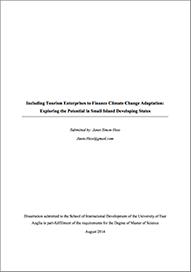Including Tourism Enterprises to Finance Climate Change Adaptation: Exploring the Potentials in Small Island Developing States


Abstract
Worldwide tourism is one of the largest global industries and is the main economic sector of many Small Island Development States (SIDS). Unfortunately the tourism industry in SIDS will be adversely affected by climate change impacts. The impact magnitude, geographical attributes, and economic dependencies on tourism markets make many SIDS particularly vulnerable thus making them likely to face significant adaptation costs. In the UNFCCC Cancun agreement SIDS were declared to receive prioritization in funding for adaptation from international climate finance. Part of this funding is supposed to come from the private sector. Adaptation interventions funded by Multinational Tourism Corporations (MNTCs) could theoretically be accredited to this private sector sourcing.
Based on these assumptions, this study aims to explore different participatory opportunities of the tourism industry to finance climate change adaptation in SIDS and seeks to estimate advantages and barriers of certain fiscal and political instruments. The study is based on an extensive literature review and nine expert interviews. The exploration reveals that there is an overall high potential to involve the tourism industry in adaptation finance. The adaptive capacity of industry stakeholders, operational scales, and customer demands are key determining factors shaping this potential. Water and energy efficiency programs prove to be promising for accommodation suppliers. Regional and local adaptation funds appear to be a suitable instrument to involve a whole range of stakeholders operating in a certain area. These funds, as well as risk transfer mechanisms, Public-Private Partnerships (PPPs), and an international adaptation finance scheme could be the most feasible instruments to accredit adaptation finance by MNTCs to the private sector sourcing of international climate finance. Despite the high potential of certain instruments, the price sensitivity of the industry needs to be taken into consideration and possible consequences of interventions should be carefully investigated.
Conclusions of the study
This exploration showed that there are several promising instruments to involve the tourism industry of SIDS in adaptation finance. However, the willingness of industry stakeholders to get involved in financing climate change measures varies significantly due to their adaptive capacity and operational scale.
Whereas multinational tour operators have the highest flexibility and are not overly excited about financing adaptation measures, local hotel owners are the most inflexible stakeholders and tend to be more perceptive to adaptation investments. As the tourism industry is generally highly price sensitive they are more receptive of implementing certain measures if threats and opportunities are communicated in economic terminology. Table 5 displays that different instruments proofed to be suitable for various stakeholders and purposes. For accommodation suppliers operating locally, measures in water efficiency and energy supply appeared to be the most cost effective and thus feasible interventions. On a destination or regional scale adaptation funds, risk transfer mechanisms, and PPPs proved to be particularly promising. Particularly, adaptation funds were widely acknowledged by the interviewees for their higher feasibility as they are respectively more transparent than taxes or levies and the industry could hold positions within the management board of the fund.
In perspective to investments by MNTCs that are theoretically most feasible to accredit them to the private sector sourcing of the $100 billion target by 2020, another set of instruments appeared to be promising. Namely, a form of an adaptation fund, PPPs, risk transfer mechanisms, and an international adaptation finance scheme is useful. However, the investigation clearly demonstrated that the adaptation finance scheme is only theoretically applicable and would face significant challenges to be realized.
Nonetheless, it will be a challenge to involve the tourism industry for adaptation finance in SIDS. Varying incentive structures, the overall price sensitivity of the sector, and the flexible nature of tourism, calls for some frameworks by the governments to encourage action. Moreover, the investigation clearly showed that approaching the sector should be based on demonstrating cost-efficient interventions or possible threats, using economical terminology. Such an approach increases the chances of gaining the attention of firms, raising awareness, and creating a knowledge base on which the further necessities of adaptation action can be communicated.
Suggested citation
Hess, Janto S. (2014): Including Tourism Enterprises to Finance Climate Change Adaptation: Exploring the Potential in Small Island Developing States. Norwich: University of East Anglia.
(0) Comments
There is no content